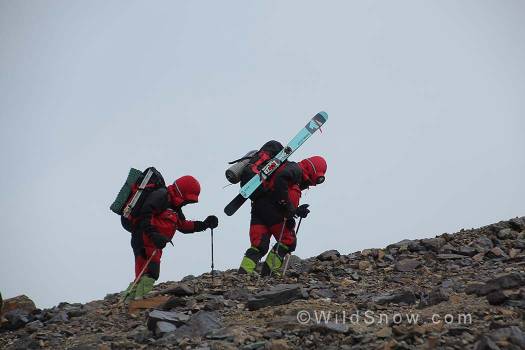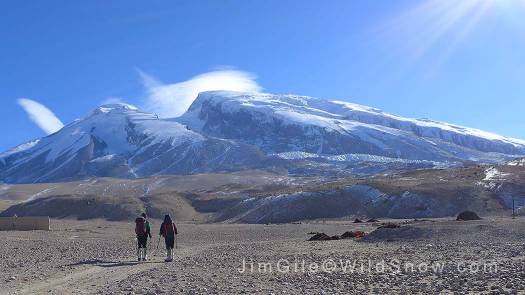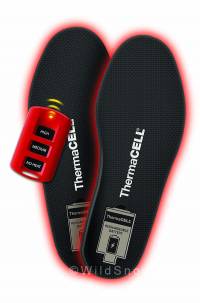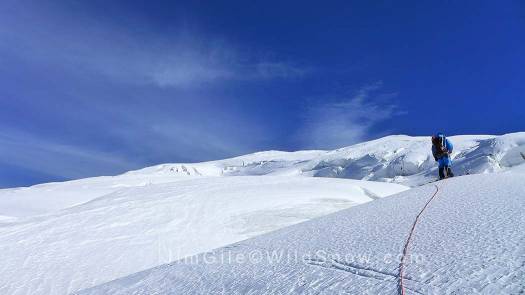Shop for Thermacell ProFlex here
Editor’s note: Mike Marlot owns 8Kpeak. Normally we don’t encourage our advertising partners and others on the business side to write about their products. Yet we do make exceptions. With so many people battling cold feet, we figured getting Mike’s take published ASAP is appropriate reader service. Note we’ve not yet tested these foot warmers ourselves, but we’ve heard good feedback so we’re comfortable with this mostly positive take.

Temperature about –50 with 100mph winds. At one point I looked back and with a full pack, my brother Steve was cartwheeling across the lower face in the wind.
At 28,000 feet, climbing in unusually cold weather and without supplemental oxygen, I came to my limit. My feet became totally numb, and I had to turn around. I did not freeze my toes, but they were numb for the better part of a year and unfortunately have never totally recovered.
Lucky I decided to turn around that night back in 2007, otherwise I might not have made it back home. But my passion for high altitude mountaineering was still well in place, and the objectives were only getting more extreme. I had to find a solution. My quest led to something that historically has not been included in haul bags for major backcountry ski expeditions: electrically heated insoles.
By the early 1990’s, we where honing our cold weather climbing in Alaska and Canada in the beastly peaks of the Denali and Wrangell ranges. We managed to climb and ski in extremely cold conditions, struggling at times with keeping our feet warm. The thought of heated insoles never came to mind.
The technology was definitely in development and until several years later, it was not conducive nor practical for expedition application. A main reason was solar technology for expeditions had not been developed to any practical extent.

Mustagh Atta winter 2014. So cold you have to approach base camp with altitude boots. Temps on the plateau were –20. On the upper slopes, without wind chill, temps were –95 to –100.
So despite the –30 and even –40 temperatures, heated foot gear was not imagined. We relied on vapor barrier socks, closed cell liners, and over-boots to allow us to head into the hills. By using all the tricks we kept our feet warm, barely.
By 1997, however, we graduated into major league mountaineering with an expedition to the 12th highest peak in the world, Broad Peak at 8,051 meters / 26,414 feet. For the first time, I experienced the debilitating effects of extreme cold and altitude, and at 25,000 feet, I had severely cold and numb feet. I was able to warm my feet with the usual leg swinging, but cold feet are miserable and dangerous. I vowed to figure out alternatives.
We researched the technology and in 2000 we were introduced to the “state of the art” with a product called Hotronics. We used them locally for training, and when they worked, they worked well. The issues was that it was primarily a ski boot product and the friction from climbing in AT boots destroyed the battery wires. We did our best to protect the wires, and despite the weight and cumbersome aspect of big battery packs hanging off our boots we headed to another 8,000 meter peak, Shishapangma.
By the time we made the trek to our advance base camp, the wire issue was moderately resolved, but now the issue was that the batteries being subjected to round the clock cold in our bags rendered them completely useless. The batteries were standard Nicad which loses power in the cold, and they would not even turn on. Once again, this time at over 26,000 feet, I found myself with numb toes.
After Shish, it became evident the technology was simply not up to snuff. From 2003 to 2007 we had messed around with improved versions of Hotronics, but still had the same issues rendering them incompatible for our objectives.
We tried other heated insoles and just could not find anything that worked. In 2012, once again, we considered Hotronics. They had made significant improvements to their product with better materials, lighter more efficient battery packs, but still had not been able to convert to the use of Lithium batteries.
Lithium is critical in that it actually provides electricity in cold temperatures. For example, if you’re using a camera in cold temperatures it is the only solution.
Despite the lack of lithium batteries with the Hotronics, we tried to insulate the nicad batteries for a winter expedition to a peak in northern China where we knew the temperatures would be in the negative triple digits. Sadly, the battery packs froze before we could even get them on our boots. We attempted the peak with overboots on our AT boots but the cold was too intense. We turned around and vowed to return.
Upon returning home, I was catching up on work at my office and I came across an email for a remote controlled heated insole that used an integrated lithium battery: Thermacell Heated Insoles. I was skeptical at best, but it got my attention. I ordered a pair — I had nothing to lose.
I charged them up, put them in my boots and tested them during a week of –20 degree days. They worked! I continued to test them for the rest of that season and by the end of the year made a call to the company, Schwabel Technologies, excited to tell them what I had been up to.
I inquired first for a sponsorship and we worked out the details for another expedition and film. It was an incredible scenario. As we climbed and skied with warm feet and brain stormed the idea of bringing the product to our demographic of climbers and skiers. Next trip we flew to Boston to meet with their team.
In Boston, we made a pitch to sell the product. In our 25 years of mountaineering, half of which included sponsorships for virtually all our gear, we never thought to actually sell what we used. Thermacell however worked so well we decided to take our story of this “golden widget” and see what we could do. We ordered a large amount of inventory and sold them all.
Thermacell had no wires to break, no battery packs hanging off our boots, and with a switch akin to an automobile door lock, we could generate two levels of heat, medium and high. It was a dream product for what we needed.
The original product did have some limitations. Charging required taking it out of the boot to plug it it, and it was a bit stiff and thick for normal ski boots.
We talked to the manufacturer, and the evolution produced the Thermacell ProFlex. This model was flexible, slightly thinner, but also had a replaceable battery pack that could be taken out and charged on a USB port or wall socket. But it had another immensely valuable aspect. The fact that the batteries could be replaced allowed for on the fly new batteries. On high, we were getting 3-4 hours of continues heat, but with this added aspect, we could simply pull our foot out, change the battery, and in a few seconds, have another 3-4 hours of heat. (Note, to change batteries you do have to take your foot out of the boot, which can of course be problematic to say the least. Planning ahead is essential, and battery power conservation can be important.)
The batteries are about the size of a match book so weight is not much of an issue. With that, 8kpeak was born. We started a blog and small store front that sold the gear we used “that worked.”
The ProFlex is selling. We will be taking the product with us on our next winter Himalayan expedition in January knowing that the technology has finally reached viable standards.
As with any product, there’s still room for improvement. The insoles are a bit thicker than the standard insole that comes in a boot so that is an issue. For people with tight fitting ski boots, the product will not work. For high level on-mountain skiers, the thickness can be an issue. It also will not work over an orthotic. For the future, we are exploring some type of orthotic interface, but for now the ProFlex is a stand along insole. But for most AT boots which people fit on the large size for warmth, it works.
For me and my team the product is a total game changer for mountaineering and skiing in general, and we hope to continue to meet the demands of all cold weather activities from climbing and skiing the highest and coldest peaks in the world, to walking the dogs on a chilly morning.
Shop for Thermacell ProFlex here


